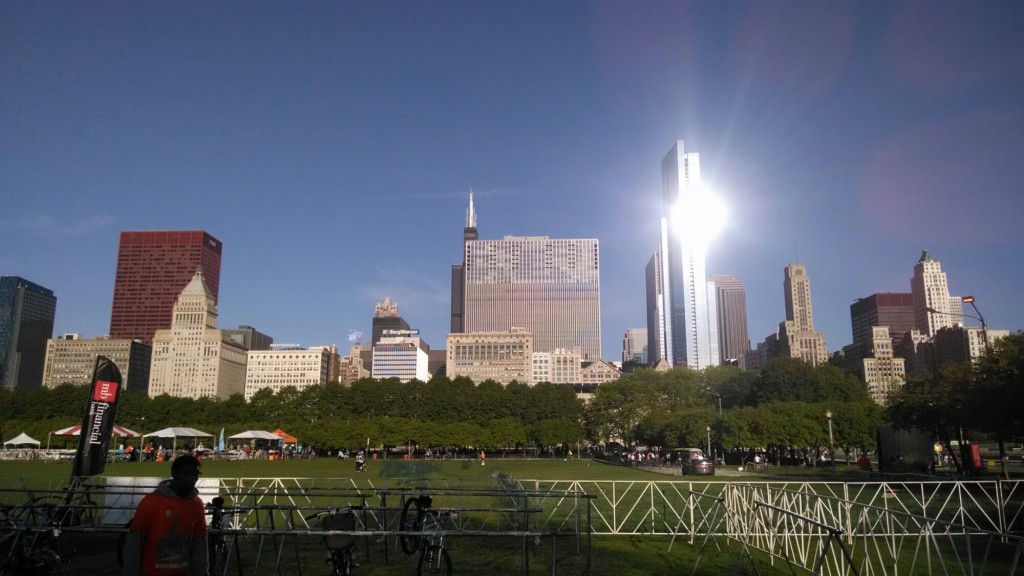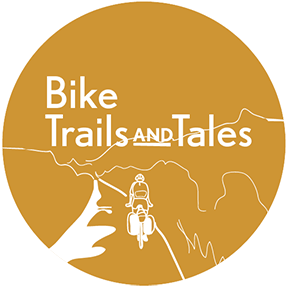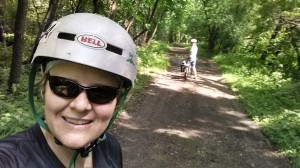
Bike the Drive – Chicago 2014
This past Sunday I rode in Chicago’s Bike the Drive, as a training ride. It was a perfect day for riding – blue skies and about 70 degrees. I’d say it’s been the best day of the year, weather-wise! In this event, Lake Shore Drive is completely closed to cars, and overtaken by cyclists.
I met M. and B. (and their 6-year-old son, on one of those connected bike thingies) at 6 a.m. and we rode to the Museum of Science and Industry together. After a short break, and a couple of muffins, I decided to pick up the pace a bit and ventured off on my own. I rode north all the way to Lawrence, exited, and then headed West to pick up the North Shore Channel Trail, for some additional riding.
Now, I have to admit that I deal with a major fear cycling in the city. A couple of years ago, a driver opened her car door into the bike lane and sent me flying over my handlebars. I was mostly okay physically, but I’ve mostly given up bike commuting and riding in the city streets – after about 5 years of bike commuting year-round.
Before I got doored, I had always imagined that I would somehow be able to “sense” when a car door was about to be opened and therefore avoid it. I also obey the rules of the road while cycling, and I believed (and still do) that doing so adds to a more orderly and therefore safe traffic experience for all.
After experiencing the split-second quickness of it in reality, I understand now that cyclist are still almost completely reliant on drivers looking out for cyclists before they open their doors. I’m just no longer confident in people to put my life in their hands like that, as a daily commuter. But, I continue to work through this fear, controlling what is in my control as a cyclist – such as obeying the rules of the road, using lights, and not being distracted.
Last year, I did the Ride for AIDS Chicago, which is almost completely on roads, and that was a big step. I also learned that, for me, training is important to being able to ride with that fear. Near the end of the first day of riding during the AIDS Ride (about 80 miles in or so), I was mentally and physically fatigued. When I’m in that state, I have less energy to counter and quiet all of those “what ifs?” What if this car that’s coming up behind me doesn’t see us? What if I’m dehydrated and don’t realize it? What if I flip over my handlebars going down this next hill? (Seriously). By the end of the first day, I had almost talked myself out of riding the next day, which entails riding the 100 miles back home. I was convinced that I should put my bike in one of the sag vans, hang my head, and ride home with the crew teams the next day.
After more than 10 years of endurance events, I fully appreciate that, for me, an important part of the experience is being aware of when I’m physically unable to continue and being aware of when my mind is just making me think I can’t or shouldn’t continue. One Day 2 of the AIDS Ride, I awoke with a fresh mindset. The fears were, of course, still lingering. For me, the importance of training for endurance events is getting somewhat accustomed to the changes in that happen in my mind and body when I am fatigued – especially the fears that come to the surface.
I’d also add that doing endurance events in a group has also helped me tremendously – especially last year’s AIDS Ride and events like the Tough Mudder. Nearly everyone will experience the ups and downs of an endurance event or trip. There’s something to knowing that we’re not suffering alone that somehow makes a difficult experience less difficult, I think. Anyway, my training schedule for the next month is to do 2 rides during the week on my bike trainer (indoors) and at least 1 long ride on the weekends (indoors or outdoors).
Onward we go!




Recent Comments